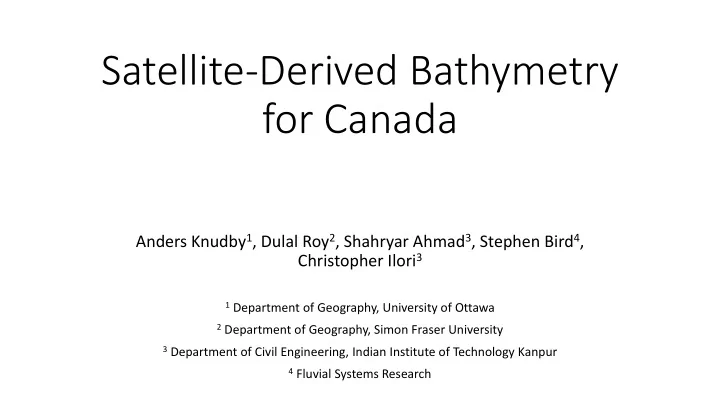

Satellite-Derived Bathymetry for Canada Anders Knudby 1 , Dulal Roy 2 , Shahryar Ahmad 3 , Stephen Bird 4 , Christopher Ilori 3 1 Department of Geography, University of Ottawa 2 Department of Geography, Simon Fraser University 3 Department of Civil Engineering, Indian Institute of Technology Kanpur 4 Fluvial Systems Research
Three main approaches to SDB, based on… Ocean colour Photogrammetry Waves
Study areas: ( Iqaluit, NU ) Boundary Bay, BC Kornati National Park, Croatia Georgian Bay, ON
Study areas: Boundary Bay Georgian Bay Kornati NP
Empirical approaches to SDB Chumbe Island, Tanzania
Physics-based (RTM inversion) approach Range of water quality parameters Measured seafloor reflectance Depth range fixed from 0.01 m to derived from VIIRS products spectra 10 m Forward modeling of above-surface remote sensing reflectance - R rs (0 + ) Atmospheric/adjacency correction of Landsat 8 image De-glinting Conversion to R rs (0 + ) Pixel-by-pixel inversion
Physics-based approach Depth Water colour (a, b) Seafloor type/reflectance 0.1 0.1, 0.1 Sand 0.1 0.1, 0.2 Sand 0.1 0.1, 0.1 Eelgrass 0.1 0.1, 0.2 Eelgrass 0.2 0.1, 0.1 Sand 0.2 0.1, 0.2 Sand 0.2 0.1, 0.1 Eelgrass 0.2 0.1, 0.2 Eelgrass 0.3 0.1, 0.1 Sand 0.3 0.1, 0.2 Sand 0.3 0.1, 0.1 Eelgrass . . .
Boundary Bay field test results (Landsat 8)
Boundary Bay field test results
But how much (a (and where) can we trust it??? Field validation
Per-pixel uncertainty assessment
Simulations Range of water quality parameters Measured seafloor reflectance Depth range fixed from 0.01 m to derived from VIIRS products spectra 10 m Forward modeling of above-surface remote sensing reflectance - R rs (0 + ) Derivation of sensor-environment noise as R rs (0 + )-equivalent standard deviation of de- Addition of sensor-environment noise to glinted satellite observations over forward-modeled spectra homogeneous deep water Model inversion
Simulations Noise- Original perturbed expected colour colour Depth Water colour (a, b) Seafloor type/reflectance 0.1 0.1, 0.1 Sand 0.1 0.1, 0.2 Sand 0.1 0.1, 0.1 Eelgrass 0.1 0.1, 0.2 Eelgrass 0.2 0.1, 0.1 Sand 0.2 0.1, 0.2 Sand 0.2 0.1, 0.1 Eelgrass 0.2 0.1, 0.2 Eelgrass 0.3 0.1, 0.1 Sand 0.3 0.1, 0.2 Sand 0.3 0.1, 0.1 Eelgrass . . .
Simulation results Boundary Bay Better water quality, high sun Better water quality, low sun 2.5 and 97.5 percentiles of predicted depths
Simulation results Simulation assumes best-case scenario and typical RTM inversion approach: • Perfect atmospheric correction • Perfect conversion between diffuse/directional and above/below surface radiation field • Perfect (and perfectly parametrized) RTM Simulation allows us to test things like: • The influence of water quality • Variation between sensors (noise and spectral bands) • Variations in sun angle
Additional potential for uncertainty assessment – optical closure (Brando et al. 2009) Modeled Observed
Additional potential for uncertainty assessment – substratum detectability (Brando et al. 2009) Amount of signal resulting from reflection off the seafloor earthzine.org
To do • Many more field tests (with proper instrumentation) • Sensor comparison (WorldView, Sentinel-2, EnMAP) • Bells and whistles to improve accuracy • Field-validated per-pixel uncertainty product (TVU) • Increase level of automation • Detection of inconsistencies btw. charts and SDB • Regular monitoring of areas needing attention
Acknowledgements: aknudby@uottawa.ca
Recommend
More recommend